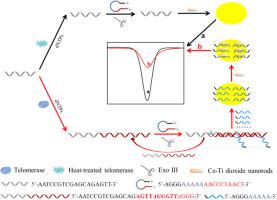当前位置:
X-MOL 学术
›
J. Electroanal. Chem.
›
论文详情
Our official English website, www.x-mol.net, welcomes your
feedback! (Note: you will need to create a separate account there.)
Electrochemical biosensor for telomerase activity assay based on HCR and dual interaction of the poly-adenine DNA with Au electrode and Ce Ti dioxide nanorods
Journal of Electroanalytical Chemistry ( IF 4.1 ) Pub Date : 2020-11-01 , DOI: 10.1016/j.jelechem.2020.114633 Yi Wang , Yuan-Jun Cai , Ru-Ping Liang , Jian-Ding Qiu
Journal of Electroanalytical Chemistry ( IF 4.1 ) Pub Date : 2020-11-01 , DOI: 10.1016/j.jelechem.2020.114633 Yi Wang , Yuan-Jun Cai , Ru-Ping Liang , Jian-Ding Qiu

|
Abstract A new electrochemical biosensor for sensitive detection of telomerase activity based on the hybridization chain reaction and the dual interaction of the poly-adenine (polyA) DNA with Au electrode and Ce Ti dioxide nanorods (Ce Ti NRs) has been constructed. Deoxynucleotide triphosphates (dNTPs) can be incorporated at the 3´-OH of TS primer by telomerase to generate the extension products with telomeric repeats (TTAGGG)n (TEP), which can hybridize with hairpin (HP) DNA and open it to form a duplex DNA with a short poly-adenine DNA single-stranded tail (s1). The duplex DNA can be recognized and selectively cleaved into single-stranded DNA fragment s1 and TEP by exonuclease III (Exo III). The released TEP can then hybridize with the HP again to initiate the s1 recycling process, which will result in the massive release of s1 fragments from HP. The s1 fragments can be immobilized on the Au electrode surface through the interaction between polyA and Au electrode on one hand. On the other hand, Ce Ti NRs can be adsorbed on the Au electrode surface by the interaction between Ce Ti NRs and the phosphate groups of s1, resulting in the decrease of the differential pulse voltammetry (DPV) current of the redox probe. The higher activity of telomerase, more HP can be hybridized and cleaved, more poly-adenine and Ce Ti NRs can be immobilized on electrode surface, and remarkable decrease of the DPV signal can be observed. The biosensor exhibited good sensitivity toward telomerase activity in HaLa cells.
中文翻译:

基于 HCR 和聚腺嘌呤 DNA 与 Au 电极和 Ce 二氧化钛纳米棒双重相互作用的端粒酶活性测定电化学生物传感器
摘要 基于杂交链反应和聚腺嘌呤 (polyA) DNA 与 Au 电极和 Ce Ti 二氧化钛纳米棒 (Ce Ti NRs) 的双重相互作用,构建了一种用于灵敏检测端粒酶活性的新型电化学生物传感器。三磷酸脱氧核苷酸 (dNTPs) 可通过端粒酶掺入 TS 引物的 3´-OH 处,生成具有端粒重复序列 (TTAGGG)n (TEP) 的延伸产物,可与发夹 (HP) DNA 杂交并将其打开形成带有短聚腺嘌呤 DNA 单链尾 (s1) 的双链 DNA。双链DNA可以被核酸外切酶III(Exo III)识别并选择性切割成单链DNA片段s1和TEP。释放出来的 TEP 可以再次与 HP 杂交以启动 s1 回收过程,这将导致 HP 大量释放 s1 片段。一方面,可以通过 polyA 和 Au 电极之间的相互作用将 s1 片段固定在 Au 电极表面。另一方面,Ce Ti NRs可以通过Ce Ti NRs与s1的磷酸基团之间的相互作用吸附在Au电极表面,导致氧化还原探针的差分脉冲伏安(DPV)电流降低。端粒酶活性越高,可以杂交和裂解的HP越多,电极表面可以固定更多的聚腺嘌呤和Ce Ti NR,DPV信号显着降低。该生物传感器对 HaLa 细胞中的端粒酶活性表现出良好的敏感性。Ce Ti NRs可以通过Ce Ti NRs与s1的磷酸基团之间的相互作用吸附在Au电极表面,导致氧化还原探针的差分脉冲伏安(DPV)电流降低。端粒酶活性越高,可以杂交和裂解的HP越多,电极表面可以固定更多的聚腺嘌呤和Ce Ti NR,DPV信号显着降低。该生物传感器对 HaLa 细胞中的端粒酶活性表现出良好的敏感性。Ce Ti NRs可以通过Ce Ti NRs与s1的磷酸基团之间的相互作用吸附在Au电极表面,导致氧化还原探针的差分脉冲伏安(DPV)电流降低。端粒酶活性越高,可以杂交和裂解的HP越多,电极表面可以固定更多的聚腺嘌呤和Ce Ti NR,DPV信号显着降低。该生物传感器对 HaLa 细胞中的端粒酶活性表现出良好的敏感性。可以观察到 DPV 信号显着下降。该生物传感器对 HaLa 细胞中的端粒酶活性表现出良好的敏感性。可以观察到 DPV 信号显着下降。该生物传感器对 HaLa 细胞中的端粒酶活性表现出良好的敏感性。
更新日期:2020-11-01
中文翻译:

基于 HCR 和聚腺嘌呤 DNA 与 Au 电极和 Ce 二氧化钛纳米棒双重相互作用的端粒酶活性测定电化学生物传感器
摘要 基于杂交链反应和聚腺嘌呤 (polyA) DNA 与 Au 电极和 Ce Ti 二氧化钛纳米棒 (Ce Ti NRs) 的双重相互作用,构建了一种用于灵敏检测端粒酶活性的新型电化学生物传感器。三磷酸脱氧核苷酸 (dNTPs) 可通过端粒酶掺入 TS 引物的 3´-OH 处,生成具有端粒重复序列 (TTAGGG)n (TEP) 的延伸产物,可与发夹 (HP) DNA 杂交并将其打开形成带有短聚腺嘌呤 DNA 单链尾 (s1) 的双链 DNA。双链DNA可以被核酸外切酶III(Exo III)识别并选择性切割成单链DNA片段s1和TEP。释放出来的 TEP 可以再次与 HP 杂交以启动 s1 回收过程,这将导致 HP 大量释放 s1 片段。一方面,可以通过 polyA 和 Au 电极之间的相互作用将 s1 片段固定在 Au 电极表面。另一方面,Ce Ti NRs可以通过Ce Ti NRs与s1的磷酸基团之间的相互作用吸附在Au电极表面,导致氧化还原探针的差分脉冲伏安(DPV)电流降低。端粒酶活性越高,可以杂交和裂解的HP越多,电极表面可以固定更多的聚腺嘌呤和Ce Ti NR,DPV信号显着降低。该生物传感器对 HaLa 细胞中的端粒酶活性表现出良好的敏感性。Ce Ti NRs可以通过Ce Ti NRs与s1的磷酸基团之间的相互作用吸附在Au电极表面,导致氧化还原探针的差分脉冲伏安(DPV)电流降低。端粒酶活性越高,可以杂交和裂解的HP越多,电极表面可以固定更多的聚腺嘌呤和Ce Ti NR,DPV信号显着降低。该生物传感器对 HaLa 细胞中的端粒酶活性表现出良好的敏感性。Ce Ti NRs可以通过Ce Ti NRs与s1的磷酸基团之间的相互作用吸附在Au电极表面,导致氧化还原探针的差分脉冲伏安(DPV)电流降低。端粒酶活性越高,可以杂交和裂解的HP越多,电极表面可以固定更多的聚腺嘌呤和Ce Ti NR,DPV信号显着降低。该生物传感器对 HaLa 细胞中的端粒酶活性表现出良好的敏感性。可以观察到 DPV 信号显着下降。该生物传感器对 HaLa 细胞中的端粒酶活性表现出良好的敏感性。可以观察到 DPV 信号显着下降。该生物传感器对 HaLa 细胞中的端粒酶活性表现出良好的敏感性。











































 京公网安备 11010802027423号
京公网安备 11010802027423号